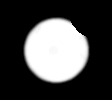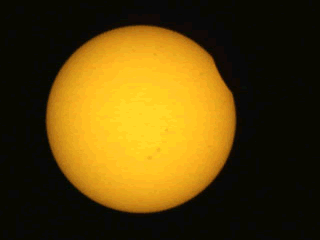|
Eclipse Facts
Date: Thursday, June 21, 2001 Time: Zimbabwe time zone, 3:09 p.m.; Universal Time (GMT/Europe), 2:09 p.m.; Eastern Daylight Time, 9:09 a.m.; and Pacific Daylight Time, 6:09 a.m. In Lusaka, totality will be for 3m38s Place: Southern Africa: The path of the total eclipse follows a northeastern trajectory from the southern Atlantic Ocean, making landfall on the west coast of Angola in southern Africa. After moving through Angola, Zambia, Zimbabwe, and Mozambique, the umbral shadow makes its final landfall in Madagascar. The penumbral shadow (the shadow of the partial eclipse) will be visible from eastern South America all the way to the bottom two-thirds of Africa. Solar eclipse -- the passage of the new Moon directly between the Sun and the Earth when the Moon's shadow is cast upon the Earth. The Sun appears in the sky either partially or totally covered by the Moon. Unfortunately, not every eclipse of the Sun is a total eclipse. Sometimes, the Moon is too small to cover the entire Sun's disk. Earth's total solar eclipse is unique in the solar system. Why? The sun is about 400 times the size of the moon and it is also about 400 times further away from the earth than the moon is. The Moon is a cold, rocky body about 2,160 miles (3,476 km) in diameter. It has no light of its own but shines by sunlight reflected from its surface. An eclipse of the Sun (or solar eclipse) can only occur at New Moon when the Moon passes between Earth and Sun. The phase known as New Moon can not actually be seen because the illuminated side of the Moon is then pointed away from Earth. The orbit of the Moon is not perfectly round but is rather oval or elliptical in shape. As the Moon orbits our planet, it's distance varies from 221,000 to 252,000 miles. This 13% variation in the Moon's distance makes the Moon's apparent size in our sky vary by the same amount The track of the Moon's shadow across Earth's surface is called the Path of Totality. It is typically 10,000 miles long but only 100 miles or so wide. In order to see the Sun totally eclipsed by the Moon, you must be in the path of totality. annular eclipse -- a solar eclipse that occurs when the apparent size of the Moon is not great enough to completely cover the Sun. A thin ring of sunlight can be seen around the black disk of the Moon. Baily's beads -- the effect seen just before and just after totality when only a few points of sunlight are visible at the edge of the lunar disk. Can see the mountains on the moon and the sun light comes thru the valleys between the mts. chromosphere -- the lower atmosphere of the Sun that appears as a thin rosy ring around the edge of the solar disk during a total eclipse. contact -- one of the instances when the apparent position of the edges of the Sun and the Moon cross one another during an eclipse. They are designated as first contact, second contact, third contact, and fourth contact.
corona -- the upper atmosphere of the Sun that appears as a halo around the Sun during a total eclipse. prominence -- a large-scale gaseous formation above the surface of the Sun. Similar to a solar flare shadow bands -- faint ripples of light sometimes seen on flat, light-colored surfaces just before and just after totality. Permanent eye damage can result from looking at the disk of the Sun directly, or through a camera viewfinder, or with binoculars or a telescope even when only a thin crescent of the Sun or Baily's Beads remain. The 1 percent of the Sun's surface still visible is about 10,000 times brighter than the full moon. Staring at the Sun under such circumstances is like using a magnifying glass to focus sunlight onto tinder. Once the Sun is entirely eclipsed, however, its bright surface is hidden from view and it is completely safe to look directly at the totally eclipsed Sun without any filters. In fact, it is one of the greatest sights in nature. There are five basic ways to observe the partial phases of a solar eclipse without damage to your eyes. We will describe each of them below. We'll also explain how to safely watch an eclipse with binoculars or a telescope. Camera and Telescope Solar Filters Fully Exposed and Developed Black-and-White Film
The Pinhole Projection Method One safe way of enjoying the Sun during a partial eclipse--or anytime--is a "pinhole camera," which allows you to view a projected image of the Sun. There are fancy pinhole cameras you can make out of cardboard boxes, but a perfectly adequate (and portable) version can be made out of two thin but stiff pieces of white cardboard. Punch a small clean pinhole in one piece of cardboard and let the sunlight fall through that hole onto the second piece of cardboard, which serves as a screen, held below it. An inverted image of the Sun is formed. To make the image larger, move the screen farther from the pinhole. A second technique for viewing the Sun safely is by looking at it directly through a specially designed solar filter. Such filters permit only a miniscule fraction of the Sun's light to pass through them. Advertisements for solar filters may be found in popular astronomy magazines. Welders' goggles or the filters for welder's goggles with a rating of 14 or higher are safe to use for looking directly at the Sun. They are also relatively inexpensive. Camera and Telescope Solar Filters Many telescope and camera companies provide metal-coated filters that are safe for viewing the Sun. They are more expensive than common Mylar, but observers generally like them better because they are available in various colors, such as a chromium filter through which the Sun looks orange. Through aluminized Mylar, the Sun is blue-gray. As with the Mylar, you can look directly at the Sun through these filters. Fully Exposed and Developed Black-and-White Film You can make your own filter out of black-and-white film, but only true black-and-white film (such as Kodak Tri-X or Pan-X). Such films have a layer of silver within them after they are developed. It is best to use two layers. With this filter, you can look directly at the Sun with safety. Standard or polaroid sunglasses are not solar filters. They may afford some eye relief if you are outside on a bright day, but you would never think of using them to stare at the Sun. So you cannot use sunglasses, even crossed polaroids, to stare at the Sun during the partial phases of an eclipse. They provide little or no eye protection for this purpose. For people who plan to use binoculars on an eclipse, Lovi cautioned common sense. Totality can and should be observed without a filter, whether with the eyes alone or with binoculars or telescopes. But the partial phases of the eclipse, right up through the Diamond Ring Effect, must be observed with filters over the objective lenses of the binoculars. Only when the Diamond Ring has faded is it safe to remove the filter. And it is crucial to return to filtered viewing as totality is ending and the western edge of the Moon's silhouette begins to brighten. After all, binoculars are really two small telescopes mounted side by side. If observing the Sun outside of eclipse totality without a filter is quickly damaging to the unaided eyes, it is far quicker and even more damaging to look at even a sliver of the uneclipsed Sun with binoculars that lack a filter. Adapted from Totality - Eclipses of the Sun Second Edition, by Mark Littmann, Ken Willcox and Fred Espenak. What's So Special About Eclipses If you've ever seen a solar eclipse on television or seen pictures in a book, dismiss those images. They don't begin to tell the story. If that's all there were to the event, there wouldn't be tens of thousands of people traveling across countries and continents to get to the eclipse. Everyone would watch it on the evening news. Here's a brief overview of what the TV images cannot show you. The partial eclipse begins about an hour before the total eclipse. During that period, the silhouette of the Moon starts to pass in front of the disc of the Sun. If you look toward the bright Sun through a protective filter, you can see by eye that the black outline of the Moon's disc is creeping across the Sun's disc very gradually. All around you, the air takes on a strange hue and an eeriness that is not seen under any other conditions. As the eclipse advances, all of nature senses the change. Birds come to roost, cocks will crow, and all manner of animals and plants revert to their nighttime posture even in the middle of the day. So you can already see that the phenomenon is considerably more influential to nature than, say, the Sun going behind a cloud. Clouds block the light of the Sun, but eclipses block all wavelengths of solar radiation. The landscape gets progressively darker, and temperatures start to drop. Only those standing under the approaching shadow sense these effects. If one looks at the ground under a tree with leaves, or anywhere light from the Sun passes through small spaces, each such hole will project an image of the crescent Sun blocked by the advancing Moon on the ground. Hundreds of crescent images may be visible all over the ground. If one has a view toward the west, the advancing shadow of the total eclipse may be visible even before it arrives. It is especially noticeable if a cloud bank or bright landscape is in the direction where the blackness will cover it before it reaches your own position. The shadow advances at an average rate of 50 km (30 miles) per minute. In the final minutes before the eclipse becomes total, many more things happen. Shadow bands may suddenly appear and shimmer over all ground objects. The Sun's atmosphere, called its corona, starts to become visible as a bright ring around the black lunar disk. The disappearing crescent shrinks to a brilliant gem on the edge of the brightening corona. This effect is called the "diamond ring". Mountains along the lunar limb break up the last of the crescent into "Baily's beads". The inner solar atmosphere, called the chromosphere, makes its reddish presence known – called the "flash spectrum". Brighter stars and planets appear. Solar prominences, gigantic explosions along the Sun's limb, may be seen with the aid of binoculars. A total solar eclipse is a multifaceted experience, and the impression it leaves on the viewer is one of awe. Where will the 2001 eclipse be visible? Somewhere in the world, there is a total eclipse of the Sun almost every year. But each is visible only in such a narrow path that, if you stand and wait for one to come your way, the average wait will be 400 years. That is why people who wish to view what has been called nature’s most beautiful spectacle must travel to do so. For North American observers, the last total solar eclipse was visible from Hawaii and Mexico in July 1991. Regrettably, the next one will not occur until the year 2017, when a total solar eclipse can be seen in a narrow band across parts of the United States. For the coming 2001 total eclipse, Africa is the best land area for viewing. On June 21, 2001, the shadow of the Moon will first touch the Earth in the South Atlantic off the coast of Brazil, and rush eastward across the Atlantic Ocean toward its first landfall in Angola, Africa. It then crosses Zambia, Zimbabwe, Mozambique, and Madagascar, ending at sunset in the Indian Ocean.
|

